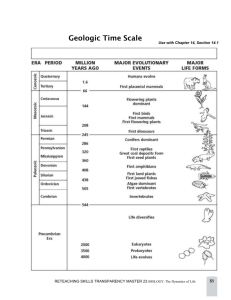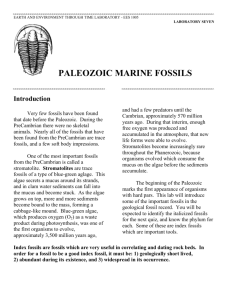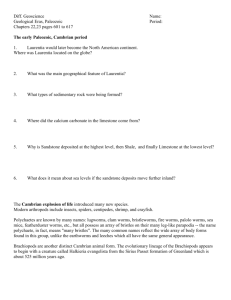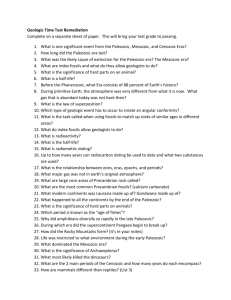Chapter 12
advertisement
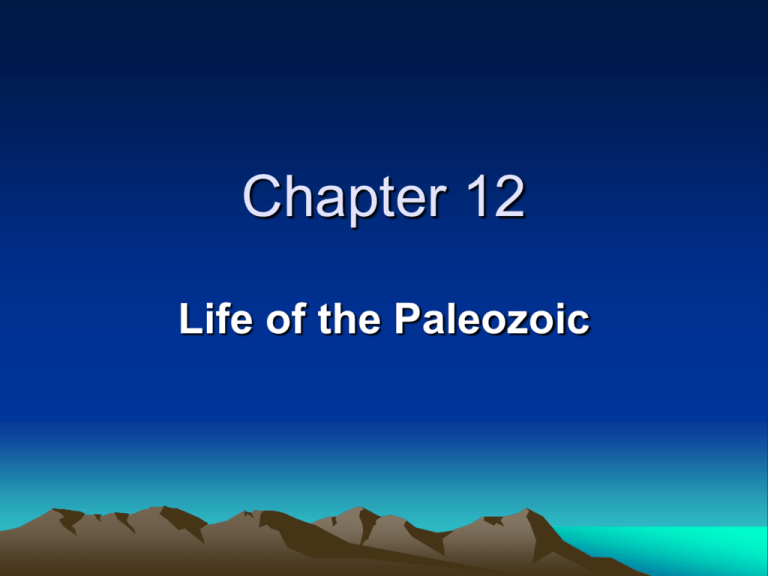
Chapter 12 Life of the Paleozoic Paleozoic overview Paleozoic Fossil Record The Paleozoic was a time with abundant fossils of multicellular organisms with shells. As a result, the fossil record improves dramatically at the beginning of the Paleozoic Era. Paleozoic Invertebrates • Representatives of most major invertebrate phyla were present during the Paleozoic, including sponges, corals, bryozoans, brachiopods, molluscs, arthropods, and echinoderms. • Almost all of the common invertebrate phyla in existence today had appeared by the Ordovician. Paleozoic Vertebrates • Vertebrates evolved during the Paleozoic, including: – Fishes – Amphibians – Reptiles – Synapsids (“mammal-like reptiles”) • The first vertebrates were jawless fishes, which are found in rocks as old as Cambrian in China. Paleozoic Vertebrates • An advanced lineage of fishes with primitive lungs and stout fins gave rise to the four-legged animals or tetrapods. • The transition from water-dwelling vertebrates to land-dwelling vertebrates depended on the evolution of the amniotic egg. Paleozoic Plants • The first primitive land plants appeared near the end of the Ordovician. • Vascular plants expanded across the land, forming great forests in the Devonian. • The plants progressed from seedless, spore-bearing plants to plants with seeds but no flowers (gymnosperms). Paleozoic Extinctions • Several mass extinctions occurred during the Paleozoic, including the largest extinction of all at the end of the Permian. • Other mass extinctions occurred at the end of the Ordovician and Devonian periods. Paleozoic Life Summary of invertebrate phyla Paleozoic life includes some Precambrian forms, which survived into the Paleozoic, as well as more advanced forms: – Unicellular eukaryotes – Animals • Invertebrates • Vertebrates – Plants Adaptive Radiations and Extinctions • The Paleozoic was a time of several adaptive radiations and extinctions. • Many geologic periods began with adaptive radiations (times of rapid evolution). • Several periods ended with extinction events of varying severity. • The extinction event at the end of the Permian Period was the worst mass extinction in the history of life. Diversity in the Paleozoic Red arrows mark extinction events Soft-bodied Animals • Multicellular animals evolved in the Precambrian. Soft-bodied Ediacaran-type organisms ranged into the Cambrian period. • Soft-bodied fossils are infrequently preserved. • Preservation improved with the origin of hard parts. • The first animals with shells are called small shelly fossils. • Small shelly fossils are found at the base of the Cambrian, and in the late Neoproterozoic. • Most disappeared by the end of the first stage of the Lower Cambrian. Small Shelly Fossils • Many had phosphatic shells, few mm in size. • Shells and skeletal remains of primitive molluscs, sponges, and animals of uncertain classification, such as Cloudina, that secreted a calcareous tube. Cambrian Diversification • The initial Paleozoic diversification is known as "the Cambrian explosion“. Abrupt appearance of many types of animals about 535 million years ago, followed by rapid evolution. • During that episode of explosive evolution, all major invertebrate phyla appeared in the fossil record (except Bryozoa). • Sometimes this event is referred to as "evolution's big bang". Cambrian Substrate Revolution • Infaunal, burrowing animals evolved rapidly during the Cambrian, as indicated by trace fossils and bioturbation of sediments. • The dramatic change in the character of the seafloor sediments (from undisturbed to highly burrowed) has been called the "Cambrian substrate revolution". Soft-Bodied Fossils in the Burgess Shale The extraordinarily well-preserved Middle Cambrian Burgess Shale fauna of Canada provides a window into the past to view the spectacular diversity of the Middle Cambrian. Many soft-bodied organisms are preserved in black shale, along with the soft parts of animals with shells, such as legs and gills of trilobites. Soft-Bodied Fossils in the Burgess Shale • The significance of the Burgess Shale is that is records soft-bodied organisms, and the soft parts of organisms with shells . The finely detailed preservation reveals the extraordinary diversity and evolutionary complexity that existed near the beginning of the Paleozoic. • Fossil sites containing abundant fossils with extraordinary preservation are called lagerstatten. Both the Burgess Shale and the Chengjiang fauna in China are lagerstatten. Animals in the Burgess Shale 1. Several groups of arthropods, including trilobites and crustaceans 2. Sponges 3. Onycophorans 4. Crinoids 5. Molluscs 6. Corals 7. Three phyla of worms 8. Chordates (Pikaia) 9. Many others Stratigraphic setting of the Cambrian Burgess Shale • Location of the Burgess Shale fauna in British Columbia, Canada • C = Onycophoran, Aysheaia, intermediate in evolution between segmented worms and arthropods. D = Arthropod Leanchoila E= Arthropod Waptia Pikaia - One of the Oldest Chordates • Pikaia is a fish-like lower chordate from the Burgess Shale. • Modern representatives are called lancelets, such as the genus Amphioxus. Chordates • Chordates have a notochord or dorsal stiffening rod associated with a nerve chord, at some stage in their development. • In vertebrates, the notochord is surrounded by and usually replaced by a vertebral column during embryonic development. • Vertebrates are chordates, but Pikaia pre-dates the evolution of vertebrae. • It is thought that vertebrates evolved from organisms similar to Pikaia. Predators in the Cambrian Seas • The giant predator of the Cambrian seas, Anomalocaris, up to 60 cm long. • Predators would have caused selective pressures on prey. The need to avoid being eaten probably encouraged the evolution of hard protective shells. • Predation probably also caused an increase in diversity of prey, as they evolved to better survive predation. Other Burgess Shale Animals • Marrella, a "lace crab“, is common in the Burgess Shale. • Hallucigenia, an onycophoran, was originally interpreted to walk on its spines, until claws were discovered on its “tentacles”. The Significance of the Burgess Shale The significance of the Burgess Shale is that it records soft-bodied organisms, and the soft parts of organisms with shells. The finely detailed preservation reveals the extraordinary diversity and evolutionary complexity that existed near the beginning of the Paleozoic. Exceptional Preservation • Fossil sites containing abundant fossils with extraordinary preservation are called lagerstatten. • Both the Burgess Shale fauna and the Chengjiang fauna from China are considered to be lagerstatten. The Chengjiang fauna • In 1984, the Lower Cambrian (535 my old) Chengjiang fossil site was discovered in Yunnan Province, China. • More than 100 species of invertebrates have been found, with extraordinary preservation, including many soft bodied forms The Chengjiang fauna • • • • • • • • • Jelly fish Annelid worms Cnidaria Porifera (sponges) Brachiopods Arthropods Early chordates similar to Pikaia The world's oldest known fish (Myllokunmingia) Other species of unknown phyla Oldest Known Fish The world's oldest known fish, Myllokunmingia, from the Maotianshan Shale near Chengjiang, in the Yunnan Province of China. 535 million years old. Ordovician Diversity • Following a slight dip in diversity at the end of the Cambrian, the Ordovician was a time of renewed diversification. • Global diversity tripled. • The number of genera increased rapidly, and the number of families increased from about 160 to 530. • The increase was particularly dramatic among trilobites, brachiopods, bivalve molluscs, gastropods, and corals. Late Ordovician Extinction • An extinction event at the end of the Ordovician led to an abrupt decline in diversity. • This extinction event was apparently related to the growth of glaciers in Gondwana, coupled with a reduction in shallow water habitat associated with the lowering of sea level. Diversity in the Paleozoic Red arrows mark extinction events Silurian Diversity Diversification of marine animals occurred again at the beginning of the Silurian Period. The period ended with only a slight drop in diversity. Devonian Diversity • The Devonian saw continued diversification, but ended with another fairly large extinction event, which extended over about 20 million years. • Roughly 70% of marine invertebrates disappeared. • Because of the long duration, the extinction is unlikely to have been caused by a sudden, catastrophic event. Carboniferous-Permian Diversity • In the early Carboniferous, diversity once again increased. • Diversity of marine animals remained fairly constant throughout the Carboniferous and Permian. • The Late Permian is marked by a catastrophic extinction event which resulted in the total disappearance of many animal groups. Overview of Changes in Diversity Through Time 1. Several of the periods of the Paleozoic ended with extinction events 2. The beginning of most of the periods of Paleozoic were marked by adaptive radiations 3. Maximum diversity in the Paleozoic seas maintained roughly constant at between 1000 and 1500 genera 4. The largest extinction occurred at the end of the Permian 5. Recovery of diversity in the Mesozoic was slow (Triassic and Jurassic) 6. Diversity increased rapidly in the Cretaceous 7. Another mass extinction occurred at the end of the Cretaceous 8. Diversity increased extremely rapidly, at unprecedented rates, at the beginning of the Cenozoic 9. Diversity in the Cretaceous, and Cenozoic Era was much greater than during the Paleozoic Diversity in the Paleozoic Red arrows mark extinction events Unicellular Organisms in the Paleozoic Seas • The principal groups of Paleozoic unicellular animals with a significant fossils record are the foraminifera and the radiolaria, which belong to Phylum Sarcodina. • These organisms are unicellular eukaryotic organisms, and belong to Kingdom Protista. Foraminifera • Name: Foraminifera means "hole bearer". • Chief characteristics: – Unicellular. – Related to the amoeba, with pseudopods. – Foraminifera build tiny shells (called tests) which grow by adding chambers. – Some species (called agglutinated foraminifera) construct tests of tiny particles of sediement. This is the earliest type of foram test. – Other forams construct tests of calcium carbonate. Foraminifera • Geologic range: Cambrian to Recent. Modes of life: – Benthic or benthonic (bottom dwellers) – Planktic or planktonic (floaters). Fusulinid foraminifera (fusulinids) • Fusulinids were abundant in the Late Paleozoic (primarily Pennsylvanian and Permian). • Their tests were similar in size and shape to a grain of rice. • Their internal structure is complex and used to distinguish different species. • Important guide fossils in the Pennsylvanian and Permian because they evolved rapidly, were abundant, and widespread geographically. Radiolaria • Chief characteristics: – Unicellular. – Test or shell composed of opaline silica – Ornate lattice-like skeleton – Often spherical or radially symmetrical with spines • Geologic range: Precambrian or Cambrian to Recent. Rare in Lower Paleozoic rocks. More abundant in Mesozoic and Cenozoic. • Mode of life: Planktonic. Marine only. Radiolaria and the Rock Record • Radiolarians are important constituents of chert at certain times in geologic history. • Their tests accumulate on the seafloor today to form radiolarian ooze, particularly in deep water, where any calcium carbonate shells would be dissolved. Marine Invertebrates in the Paleozoic Seas • The fossils of shell-bearing invertebrates that inhabited shallow seas are common in Paleozoic rocks. • Archaeocyathids, sponges, corals, bryozoans, trilobites, molluscs, and echinoderms. • Many were benthic (bottom dwellers), but others, such as graptolites, were planktonic. Currents carried them over wide areas. • As a result, they are useful index fossils for global stratigraphic correlation. Phylum Archaeocyatha • Name means "ancient cup" • Chief characteristics: Conical or vase-shaped skeletons made of calcium carbonate. Double-walled structure with partitions and pores. • Geologic range: Cambrian only. Extinct. • Mode of life: Attached to the sea floor. Reef-builders. Phylum Porifera - The Sponges Name means "pore-bearing". Covered by tiny pores. Phylum Porifera - The Sponges Chief characteristics: – Globular, cylindrical, conical or irregular shape. – Basic structure is vase-like with pores and canals. – Interior may be hollow or filled with branching canals. – Solitary or colonial. – Skeletal elements are called spicules, and they may be separate or joined. – Composition may be calcareous, siliceous or organic material called spongin. Phylum Cnidaria • Corals, sea fans, jellyfish, and sea anemones. • Name: Cnidaria are named for stinging cells called cnidoblasts or cnidocytes. • Many are soft-bodied but only those which form hard skeletal structures are readily preservable as fossils. Phylum Cnidaria • Geologic range: Late Precambrian (Proterozoic) to Recent for the phylum. • The first corals were the tabulates. • Mode of life: Corals live attached to the sea floor, primarily in warm, shallow marine environments. Phylum Cnidaria – Chief Characteristics 1. Radial symmetry 2. Mouth at the center of a ring of tentacles. Phylum Cnidaria – Chief Characteristics 3. Body form may be polyp (attached to the bottom, with tentacles on top) or medusa (freeswimming, jellyfish). Chief Characteristics of Corals 1. May be solitary or colonial. Colonies are composed of many polyps living together. 2. Hard calcareous skeleton. The skeletal parts formed by polyps are called corallites. 3. The "cup", in which an individual coral polyp sits, is called the theca. Each theca is small, and roughly circular or hexagonal. 4. The theca is divided internally by vertical partitions called septae, arranged in a radial pattern. Chief Characteristics of Corals 5. Types of corals are distinguished by presence or absence, and number of septae: – Rugose corals (or tetracorals) have septae arranged in multiples of four. – Tabulate corals lack septae. – The Mesozoic and Cenozoic scleractinian corals (or hexacorals) have septae arranged in multiples of six. Rugose Corals • Most rugose corals are solitary and conical (shaped like ice cream cones). • Septae are visible in the circular opening of the cone. • Some rugose corals are colonial, having hexagonal corallites with septae (such as Hexagonaria from the Devonian of Michigan). Rugose Corals • Geologic range: Ordovician to Permian all extinct. • Rugose corals were abundant in the Devonian and Carboniferous, but became extinct during the Late Permian. Tabulate Corals • Tabulate corals are colonial and resemble honeycombs or wasp nests. • They lack septae. • They have horizontal plates within the theca called tabulae. Tabulae are one of the main features of the tabulate corals. Tabulate Corals • Geologic range: Ordovician to Permian all extinct. • The principal Silurian reef formers. • They declined after the Silurian and their reefbuilding role was assumed by the rugose corals. Modern Corals • Modern corals are scleractinian corals. Scleractinian corals have septae are arranged in multiples of six, and are sometimes called hexacorals. • Scleractinian corals did not appear until after the Paleozoic • Geologic range: Triassic to Recent. Phylum Bryozoa • Name: Name means "moss" (bryo) + "animal" (zoa). • Chief characteristics: – Colonial (many microscopic individuals living physically united adjacent to one another). – The individuals are called zooids, and they are housed in a hard "capsule" called a zooecium. – The colony is called a zoarium. Phylum Bryozoa • Individual zooecia (plural of zooecium) are very tiny (about the size of a pin-hole, a millimeter or less in diameter). They are just large enough to be seen with the unaided eye. • Bryozoans may be distinguished from corals because of the apertures in the skeleton are much smaller. Phylum Bryozoa The bryozoan colony may resemble lace or a tiny net, may be delicately branching, finger-like, circular or dome-shaped. There are more than 4000 living species of bryozoans, and nearly 16,000 fossil species. Phylum Bryozoa • Geologic range: Ordovician to Recent. • Mode of life: Widespread in marine environments. A few live in freshwater lakes and streams. Phylum Bryozoa Archimedes, from the Mississippian period, has a cork-screw-like central axis with a fragile net-like colony around the outer edge. Phylum Brachiopoda • Name: Name means "arm" (brachio) + "foot" (pod). • Chief characteristics: – Bivalved (two shells), each with bilateral symmetry. The plane of symmetry passes through the center of each shell or valve. – The two valves differ in size and shape in most. Sometimes the larger valve will have an opening near the hinge line through which the pedicle extended in life. Phylum Brachiopoda Soft parts include a lophophore consisting of coiled tentacles with cilia. The lophophore circulates water between the two valves, distributing oxygen and flushing out carbon dioxide. Water movements caused by the lophophore also transport food particles toward the mouth. Phylum Brachiopoda Mode of life: Shallow marine environments. Generally attached to the sea floor. Inarticulate brachiopods are known to live in burrows in the sediment. Brachiopods are filter feeders. Phylum Brachiopoda • Geologic range: – Lower Cambrian to Recent. – Very abundant during the Paleozoic. – A few species (belonging to only three families) remain today. Inarticulate Brachiopods • Primitive brachiopods with phosphatic or chitinous valves. • No hinge. Spoon-shaped valves held together with muscles and soft parts. • Lingula is a well known genus • Geologic range: – Lower Cambrian to Recent Articulate Brachiopods • Calcareous valves attached together with a hinge consisting of teeth and sockets. • Geologic range: Lower Cambrian to Recent • Spiny brachiopods (called productids) are characteristic of the Carboniferous and Permian. Phylum Mollusca • Clams, oysters, snails, slugs, Nautilus, squid, octopus, cuttlefish • Name: Mollusca means " soft bodied". Phylum Mollusca • Chief characteristics: – Soft body enclosed within a calcium carbonate shell. – A few, like slugs and the octopus, have no shell. – Muscular part of body of clams and snails and some other groups of molluscs is called the foot. Phylum Mollusca • Geologic range: Cambrian to Recent. • Mode of life: Marine, freshwater, or terrestrial. They may: swim, float or drift, burrow into mud or sand, bore into wood or rock, attach themselves to rocks, or crawl. Types of Molluscs 1. Monoplacophorans (Neopilina) 2. Polyplacophorans or amphineurans (chitons) 3. Bivalves or pelecypods (clams, scallops) 4. Gastropods (snails and slugs) 5. Cephalopods (squid, octopus, Nautilus) 6. Scaphopods (tusk shells) Class Monoplacophora Chief characteristics: – Single shell resembling a flattened cone or cap. – Soft part anatomy shows pseudo-segmented arrangement of gills, muscles, and other organs. Suggests that the primitive mollusc was a segmented animal. Segmentation was lost secondarily. – Monoplacophorans are regarded as ancestral to bivalves, gastropods, and cephalopods. Class Monoplacophora • Name: Monoplacophora means "single plate-bearer". • Geologic range: Cambrian-Recent, but only known as fossils from Cambrian to Devonian. Living monoplacophorans found in deep water off Costa Rica in 1952 and named Neopilina. Considered to be a "living fossil" . Class Amphineura or Polyplacophora – The Chitons Chief characteristics: Chitons have 8 overlapping plates covering an ovoid, flattened body. Class Amphineura or Polyplacophora – The Chitons • Name: Polyplacophora means " many plate-bearer" . • Geologic range: Cambrian to Recent. Class Bivalvia or Pelecypoda • Clams, oysters, scallops, mussels, rudists • Chief characteristics: – Skeleton consists of two calcareous valves connected by a hinge. – Bilateral symmetry; plane of symmetry passes between the two valves. Class Bivalvia or Pelecypoda • Name: Bivalvia means " two" (bi) + " shells" (valvia). • Geologic range: Early Cambrian to Recent • Mode of life: Marine and freshwater. Many species are infaunal burrowers or borers, and others are epifaunal. Class Gastropoda • Snails and slugs • Chief characteristics: – Asymmetrical, spiral-coiled calcareous shell. • Name: means "stomach" (gastro) + "foot" (pod). • Geologic range: Early Cambrian to Recent. • Mode of life: Marine, freshwater or terrestrial. Class Cephalopoda • Squid, octopus, Nautilus, cuttlefish • Name: means " head" (kephale) + " foot" (pod). • Chief characteristics: – Symmetrical cone-shaped shell with internal partitions called septae – Shell may be straight or coiled in a spiral which lies in a plane. – Smooth or contorted sutures visible on the outside of some fossils mark the place where septae join the outer shell. Class Cephalopoda • Geologic range: Late Cambrian to Recent. • Mode of life: Marine only; carnivorous (meat-eating) swimmers. • Types of Paleozoic cephalopods: – Nautiloids – Ammonoids – Coleoids Nautiloid Cephalopods • The shells of nautiloid cephalopods have smoothly curved septa, which produce simple, straight or curved sutures. • Geologic range: Cambrian to Recent. Ammonoid Cephalopods • Ammonoid cephalopods have complex, wrinkled or crenulated septa, which produce angular or dendritic sutures. • Geologic range: Devonian to Cretaceous all extinct. Ammonoid Cephalopods • There are three basic types of sutures in ammonoid shells: – Goniatite or goniatitic (septae have relatively simple, zig-zag undulations) – Ceratite or ceratitic (septae have smooth "hills" alternating with saw-toothed "valleys") – Ammonite or ammonitic (septae are complexly branching and tree-like or dendritic) Types of Sutures in Cephalopods Subclass Coleoidea • Belemnoids (belemnites) – Geologic range: Mississippian to Eocene - all extinct. • Sepioids (cuttlefish) – Geologic range: Jurassic to Recent • Teuthoids (squid) – Geologic range: Jurassic to Recent • Octopods (octopus) – Geologic range: Cretaceous to Recent Order Belemnoidea - Belemnoids • The belemnoids have an internal calcareous shell (which resembles a cigar in size, shape, and color) called a rostrum • The front part of this shell is chambered, as in the nautiloids and ammonoids. • The rostrum is made of fibrous calcite, arranged in concentric layers. Class Scaphopoda • Tusk shells or tooth shells • Chief characteristics: Curved tubular shells open at both ends. • Geologic range: Ordovician to Recent. • Mode of life: Marine. Phylum Arthropoda • Insects, spiders, shrimp, crabs, lobsters, barnacles, ostracodes, trilobites, eurypterids • Name: means "jointed" (arthro) + "foot" (pod). • Chief characteristics: – Segmented body with a hard exterior skeleton composed of chitin (organic material). – Paired, jointed legs. – Highly developed nervous system and sensory organs. Phylum Arthropoda • Geologic range: Cambrian to Recent. • Mode of life: Arthropods inhabit a wide range of environments. Most fossil forms are found in marine or freshwater sediments. Paleozoic Arthropods and Their Geologic Ranges • • • • • • • Trilobites - Cambrian to Permian Horseshoe crabs - Silurian to Recent Eurypterids - Ordovician to Permian Arachnids - Late Silurian to Recent Ostracodes - Cambrian to Recent Onychophorans - Cambrian to Recent Insects - Devonian to Recent Subphylum Trilobita - Trilobites • Chief characteristics: – Body has three-lobes – Skeleton composed of chitin, with calcium carbonate – Body is divided into three segments: • Rigid head segment cephalon • Jointed, flexible middle section - thorax • Rigid tail piece - pygidium Subphylum Trilobita - Trilobites • Name: Trilobite means "three" (tri) + "lobed" (lobus). • Geologic range: Cambrian to Permian • Mode of life: Exclusively marine. Most were bottom dwellers living in shallow shelf environments. Class Eurypterida - Eurypterids • Extinct scorpion-like or lobster-like arthropods. • Predators. • Up to 10 ft long. • Geologic range: Ordovician to Permian. Most are Silurian and Devonian. • Mode of life: Inhabited brackish estuaries. Class Arachnida - Arachnids • Scorpions, spiders, ticks, and mites • Scorpions are the oldest arachnids with a fossil record. • Scorpions had evolved by the Late Silurian. The earliest ones appear to have lived in the water, because their fossils have gills. • Scorpions, spiders, and mites are found in Devonian rocks. • Geologic range: Late Silurian to Recent. Class Ostracoda -Ostracodes • The ostracodes are mainly microscopic in size. • Tiny bivalved shell encasing a shrimp-like creature. • Geologic range: Cambrian to Recent. • Mode of life: Both marine and freshwater. Class Onychophora • Onychophorans share many characteristics of segmented annelid worms and arthropods, and are considered to be intermediate in evolution between the two groups. • Geologic range: Cambrian to Recent The onycophoran, Aysheaia. Class Hexapoda - Insects • The insects are among the most diverse living group on Earth, but they are rarely found as fossils. • Body is divided into three parts, head, thorax, and abdomen. • Thorax has six legs. • The earliest insects were wingless. • Winged insects appeared by the Pennsylvanian. • Geologic range: Middle Devonian to Recent. Phylum Echinodermata • Starfish, sea urchins, sand dollars, crinoids, blastoids, and others • Name: Echinodermata means "spiny" (echinos) + "skin" (derma). Phylum Echinodermata • Chief characteristics: Calcite skeleton with fivepart symmetry, superimposed on primitive bilateral symmetry. • Echinoderms have a water vascular system with water in a system of tubes within the body. • Tube feet are soft, movable parts of the water vascular system which project from the body and are used in locomotion, feeding, respiration, and sensory perception. Phylum Echinodermata • Geologic range: Cambrian to Recent. • Mode of life: Exclusively marine. Some are attached to the sea floor by a stem with "roots" called holdfasts; others are freemoving bottom dwellers. • Similarity of embryos between echinoderms and chordates suggests that they may be derived from a common ancestral form. Class Crinoidea - Crinoids • Crinoids are animals which resemble flowers. • They consist of a calyx with arms, atop a stem of calcite disks called columnals. • The crinoid is attached to the sea floor by root-like holdfasts. • Some living crinoids are swimmers, and not attached. • Over 1000 genera are known. Crinoids • Geologic range: Middle Cambrian to Recent. • Especially abundant during the Mississippian. Class Blastoidea - Blastoids • Blastoids are extinct animals with an armless bud-like calyx on a stem. • About 95 genera are known. • A common genus is Pentremites. • Geologic range: Ordovician to Permian - all extinct. Class Asteroidea - Starfish • Starfish are star-shaped echinoderms with five arms. • About 430 genera are known. • Geologic range: Ordovician to Recent. Class Ophiuroidea – Brittle Stars • Brittle stars have 5 arms, like starfish, but the arms are thin and serpent-like. • About 325 genera are known. • Geologic range: Ordovician to Recent. Class Echninodea • Sand dollars and sea urchins • Echinoids are disk-shaped, biscuitshaped, or globular. • Viewed from above, they may be circular or somewhat irregular in shape, but with a five-part symmetry. • About 765 genera are known. • Geologic range: Ordovician to Recent. Class Holothuroidea • Sea cucumbers • Soft-bodied echinoderms resembling cucumbers. • They have microscopic hard parts called sclerites in various shapes resembling hooks, wheels and anchors. • About 200 genera are known. • Geologic range: Middle Cambrian?, Middle Ordovician to Recent Class Edrioasteroidea • Edrioasteroids • A group that was probably ancestral to starfish and sea urchins. • Globular, discoidal, or cylindrical tests (shells), many of which had concave surfaces. • Geologic range: Early Cambrian to Middle Pennsylvanian. Class Cystoidea • Cystoids • This primitive group had a calyx attached to the seafloor by a stem (like crinoids and blastoids). • Distinctive patterns of pores on the plates of the calyx. • Geologic range: Cambrian to Late Devonian. Most common in Ordovician and Silurian. The Echinoderm-Backbone Connection • Echinoderms are closely related to chordates (the group that includes the vertebrates). • The early cell division, embryonic development, and larvae of echinoderms resemble those of chordates, and are different from those of other invertebrates. • Biochemistry of echinoderms is also similar to that of chordates (chemical similarities associated with muscle activity and chemistry of oxygen-carrying pigments in the blood). Phylum Hemichordata Class Graptolithina - Graptolites • Name: Graptolite means "write" (grapto) + "stone" (lithos), because they resemble pencil marks on rock. Graptolites • Chief characteristics: – Organic (chitinous) skeletons consisting of rows or lines of small tubes or cups, called thecae. – Tubes or cups branch off a main cord or tube called a stem or stipe. – Stipes may consist of one, two, or many branches. – Entire colony called a rhabdosome. – A filament at the lower end of the rhabdosome is called a nema. Graptolites • Most graptolites are found flattened and carbonized in black shales and mudstones. • Geologic range: Cambrian to Mississippian. (Most abundant in Ordovician and Silurian.) • Some living organisms which may be surviving descendants (living fossils) have been recovered in 1989 in the South Pacific and later in Bermuda. • Mode of Life: Planktonic (colonies attached to floats). Phylum Chordata • Vertebrates, sea squirts or tunicates, lancelets such as Amphioxus. • Name: "Chord" means "string", referring to the nerve cord and/or notochord. • Geologic range: Cambrian to Recent. • Mode of life: Varied. Among the vertebrates alone, various members are land dwellers, swimmers, or fliers. Paleozoic vertebrates were initially in the sea, but later colonized freshwater and land. Phylum Chordata Chief characteristics (some are embryonic): 1. Bilateral symmetry. 2. Gill slits. These slits are a series of openings that connect the inside of the throat to the outside of the "neck". 3. Dorsal nerve cord (sometimes called a spinal cord). The nerve cord runs down the "back", connecting the brain with the muscles and other organs.




